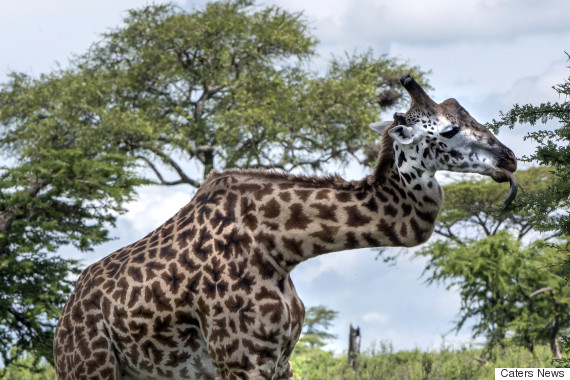Science
Related: About this forumDNA reveals that giraffes are four species — not one
Researchers previously split giraffes into several subspecies on the basis of their coat patterns and where they lived. Closer inspection of their genes, however, reveals that giraffes should actually be divided into four distinct lineages that don’t interbreed in the wild, researchers report on 8 September in Current Biology1. Previous genetic studies2 have suggested that there were discrete giraffe populations that rarely intermingled, but this is the first to detect species-level differences, says Axel Janke, a geneticist at Goethe University in Frankfurt, Germany, and the study’s senior author.
“It was an amazing finding,” he says. He notes that giraffes are highly mobile, wide-ranging animals that would have many chances to interbreed in the wild if they were so inclined: “The million-dollar question is what kept them apart in the past.” Janke speculates that rivers or other physical barriers kept populations separate long enough for new species to arise.

The researchers suggest replacing the current species name, Giraffa camelopardalis, with four new ones:
the southern giraffe (G. giraffa), found mainly in South Africa, Namibia and Botswana;
the Masai giraffe (G. tippelskirchi) of Tanzania, Kenya and Zambia;
the reticulated giraffe (G. reticulata) found mainly in Kenya, Somalia and southern Ethiopia;
and the northern giraffe (G. camelopardalis), found in scattered groups in the central and eastern parts of the continent.
The one remaining subspecies is the Nubian giraffe (G. camelopardalis camelopardalis) of Ethiopia and South Sudan. It is a distinct subspecies of the northern giraffe.
Laffy Kat
(16,383 posts)narnian60
(3,510 posts)anamandujano
(7,004 posts)[IMG]
 [/IMG]
[/IMG]
[IMG]
 [/IMG]
[/IMG]
In the first photo you can see two warthogs in the background leaving the pond.
In the second photo the giraffe is heading to a thicket where it stayed a long time eating. A little monkey was also there chowing down.
Judi Lynn
(160,545 posts)BlancheSplanchnik
(20,219 posts)<3 ❤️
ailsagirl
(22,897 posts)Thanks for posting!
bjvom
(51 posts)I have little faith in the scientific community's ability to reach a consensus on the definition of species much less the rules that govern what constitutes individual species, phylum class, order, genus, family . By the current accepted thinking, the mere fact that they don't interbreed in the wild is irrelevant to speciation. When it has been demonstrated that these (presumed) separate species are incapable of breeding , then will they be able with certainty to call them separate species. If G. tippelskirchi and G. camelopardalis are capable of producing non-sterile male offspring, they are not separate species. If they only produce a fertile female, then they are separate species.
If, on the other hand it turns out they can interbreed but something in their genomes prevents them from doing so then I believe we will have to change our definition of species.
hunter
(38,317 posts)In biology lumpers are the darlings of developers.
Killing off a minor sub-species doesn't seem so tragic as killing off an entire species.
Religious creationists (often developers themselves) may also believe that fewer animals on Noah's ark somehow makes their bizarre literal interpretation of the story less absurd.
If the definition of "species" seems important, it's probably because high school biology textbooks in the U.S.A. are about as rotten as our history textbooks, edited to appease know-nothing school board members who remember only two giraffes poking their heads out of Noah's ark in their Sunday school coloring books.
The nomenclature system of Carl Linnaeus was later essential to our understanding of evolutionary biology, but it's not definitive. As we continue to explore the actual genes of various organisms, and the various populations of organisms, many surprising things turn up, and any definitions of "species" are increasingly shifted into the realm of population biology and away from morphology.
Most biologists I've met don't get hung up on the definition of "species," focusing instead on populations of organisms and their overall genetic diversity.
Genetic diversity in a sexually reproducing population is what makes a species resilient, especially in a rapidly changing environment.
Here in the anthropocene, maintaining the genetic diversity of endangered populations is extremely important.
BlancheSplanchnik
(20,219 posts)I have a little knowledge of biology; I interpret many different classes for Deaf and hearing clients, so I get exposed to some advanced classes.
Anyway, I'm reading your post, going "Yes!! Dammit, How can we make this happen? We CANT continue to let human populations expand infinitely....not if we value what we have-- The most beautiful array of diverse nature.
Today, a truck passed by me (in some slow traffic), and I saw his license plate: WILDRNESS.
Today, President Obama ordered work stop immediately on the Dakota Pipeline going through Standing Rock, SD.
Today, Native Protectors marched to the Capital and were greeted by police. Women led the people, and police lined up courteously!!!!!
And a reception line, of greeting and handshaking, happened
I think there's powerful medicine there. (If I may use a Native American trope.)
Faith.
![]()
Judi Lynn
(160,545 posts)pansypoo53219
(20,981 posts)Towlie
(5,324 posts)yuiyoshida
(41,832 posts)had a crooked neck, at the Santa Barbara Zoo, and that used to bother me, that looked painful to me, but they said, it was just fine, and he deals with it very well.
